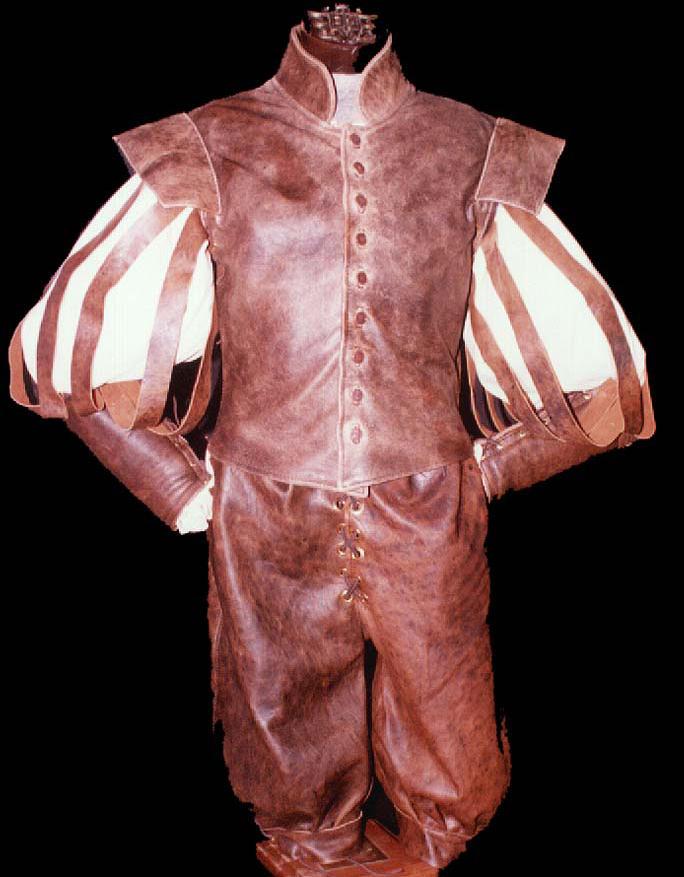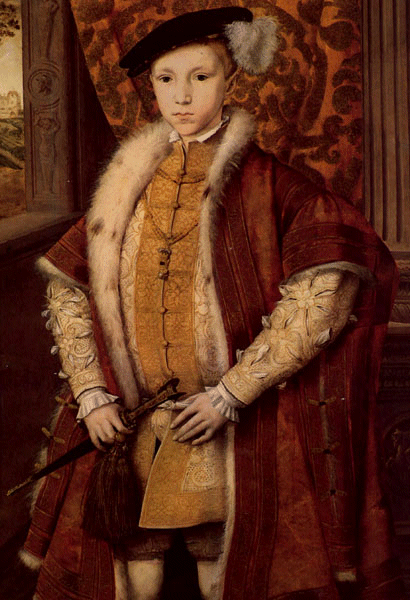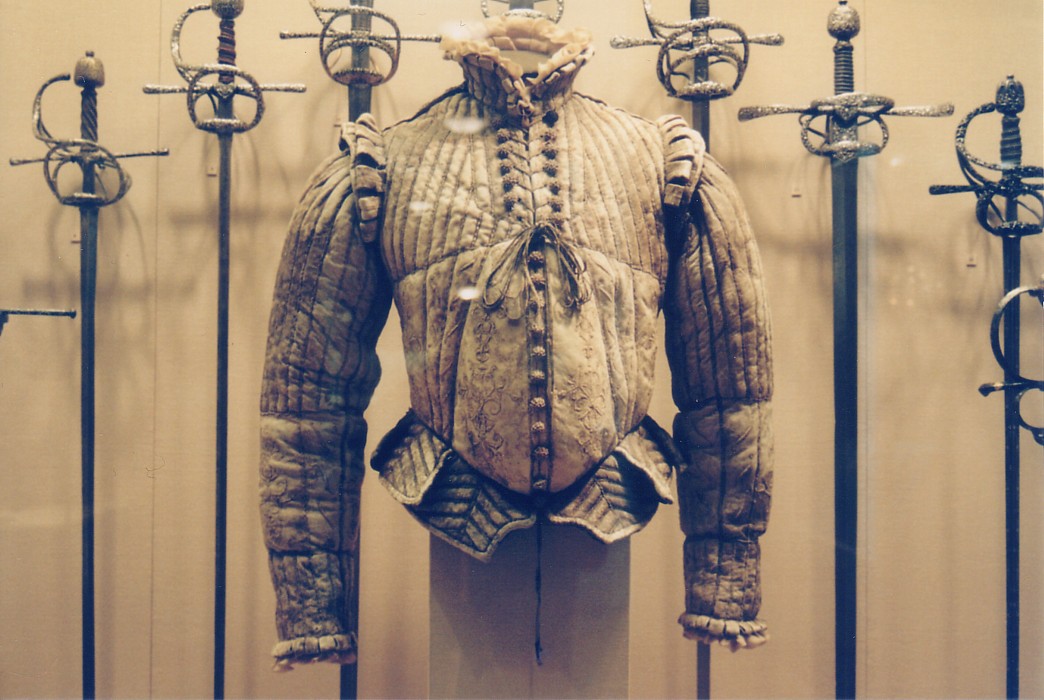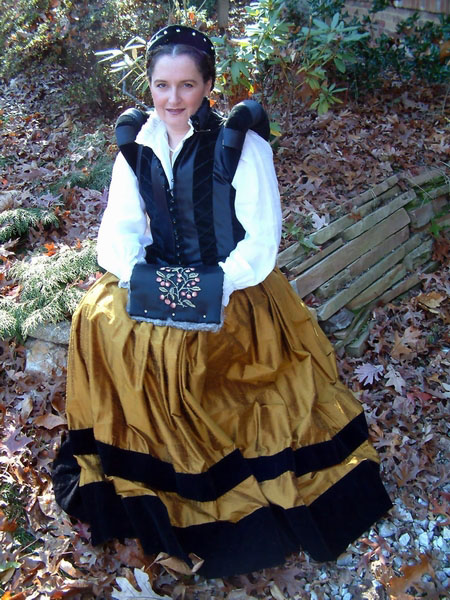Difference between revisions of "Doublet"
(New page: thumb|Modern leather doublet and breeches A doublet is a man's snug-fitting buttoned jacket that was worn in Western Europe from the Middle Ages through to the mid-17...) |
Weird Bird (talk | contribs) m (→Links: - Fixed some dead links via the Wayback Machine and removed some links to products no longer being sold.) |
||
| (7 intermediate revisions by one other user not shown) | |||
| Line 5: | Line 5: | ||
[[Image:Edward VI of England.png|left|thumb|Portrait of Edward the IV wearing a doublet and coat]] | [[Image:Edward VI of England.png|left|thumb|Portrait of Edward the IV wearing a doublet and coat]] | ||
=====Fourteenth and fifteenth centuries===== | =====Fourteenth and fifteenth centuries===== | ||
| − | Doublets of the 14th and 15th centuries were generally hip-length, sometimes, shorter, worn over the shirt and hose, with a houppelande or other form of overgown. | + | Doublets of the 14th and 15th centuries were generally hip-length, sometimes, shorter, worn over the shirt and hose, with a houppelande or other form of overgown. From the late 14th century, doublets were cut and padded to give the wearer an egg-shaped or pigeon-breasted silhouette, a fashion that gradually died out in favor of a flatter natural fit. Doublets in this time period wear called Pourpoints, and were closed with many many buttons. |
| − | From the late 14th century, doublets were cut and padded to give the wearer an egg-shaped or pigeon-breasted silhouette, a fashion that gradually died out in favor of a flatter natural fit. | ||
=====Later sixteenth century===== | =====Later sixteenth century===== | ||
| Line 12: | Line 11: | ||
In the early Elizabethan period, doublets were padded over the belly with bombast in a "pouter pigeon" or "peascod" silhouette. Sleeve attachments at the shoulder were disguised by decorative wings, tabs, or piccadills, and short skirt-like peplums or piccadills covered the waist of the hose or breeches. Padding gradually fell out of fashion again, and the doublet became close-fitting with a deep V-waistline. | In the early Elizabethan period, doublets were padded over the belly with bombast in a "pouter pigeon" or "peascod" silhouette. Sleeve attachments at the shoulder were disguised by decorative wings, tabs, or piccadills, and short skirt-like peplums or piccadills covered the waist of the hose or breeches. Padding gradually fell out of fashion again, and the doublet became close-fitting with a deep V-waistline. | ||
| − | [[Image:FencingDoublet1.jpg|Preserved Fencing Doublet, 16th Century]] | + | [[Image:FencingDoublet1.jpg|thumb|Preserved Fencing Doublet, 16th Century]] |
=====Seventeenth century===== | =====Seventeenth century===== | ||
Charles I in the doublet and breeches fastened with points of 1629, by Daniel Mijtens the Elder. By the 17th century, doublets were short-waisted. A typical sleeve of this period was full and slashed to show the shirt beneath; a later style was full and paned or slashed to just below the elbow and snug below. Decorative ribbon points were pulled through eyelets on the breeches and the waist of the doublet to keep the breeches in place, and were tied in elaborate bows. | Charles I in the doublet and breeches fastened with points of 1629, by Daniel Mijtens the Elder. By the 17th century, doublets were short-waisted. A typical sleeve of this period was full and slashed to show the shirt beneath; a later style was full and paned or slashed to just below the elbow and snug below. Decorative ribbon points were pulled through eyelets on the breeches and the waist of the doublet to keep the breeches in place, and were tied in elaborate bows. | ||
| − | + | [[Image:16thc english.jpeg|left|thumb|A lady wearing a black women's doublet, with a saffron [[skirt]] that has black gards, and a [[white]] [[chemise]]]] | |
The doublet fell permanently out of fashion in the mid-17th century when Louis XIV of France and Charles II of England established a court costume for men consisting of a long coat, a waistcoat, a cravat, a wig, and breeches—the ancestor of the modern suit. | The doublet fell permanently out of fashion in the mid-17th century when Louis XIV of France and Charles II of England established a court costume for men consisting of a long coat, a waistcoat, a cravat, a wig, and breeches—the ancestor of the modern suit. | ||
===Links=== | ===Links=== | ||
| − | *[http:// | + | *[https://web.archive.org/web/20190213071533/http://home.earthlink.net/~lizjones429/farsetto.html#background Research and how to make a 15th century Italian Doublet (Farsetto)] |
| − | *[http://www. | + | *[https://web.archive.org/web/20160123193456/http://freespace.virgin.net/f.lea/doublet1.html How to make a doublet, with a pattern made from a dress shirt] |
| − | *[http:// | + | *[http://www.extremecostuming.com/articles/adozendoubletdesigns.html a dozen doublet patterns from Extreme Costuming] |
| − | *[http:// | + | *[http://www.nachtanz.org/SReed/doublets.html 15th century doublets] |
| − | *[http://www. | + | *[https://web.archive.org/web/20150419070541/http://elizabethan-portraits.com/fencing_doublet.htm Photo Gallery of Existing Fencing Doublet] |
| − | *[http://www. | + | *[https://web.archive.org/web/20160219164626/http://www.faireware.com/doublets.html Simple Doublets] (No longer for sale, but may be used as inspiration) |
| + | *[http://www.revivalclothing.com/index.asp?PageAction=VIEWPROD&ProdID=225 Purchase Doublets] | ||
[[Category:Garb]] [[Category:European Garb]] [[Category:Amtgard Things]] [[Category:How To]] | [[Category:Garb]] [[Category:European Garb]] [[Category:Amtgard Things]] [[Category:How To]] | ||
| + | [[Category:Men's Garb]] [[Category:Women's Garb]][[Category:Spanish Garb]] [[Category:French Garb]] [[Category:English Garb]] | ||
Latest revision as of 05:53, 10 February 2024
A doublet is a man's snug-fitting buttoned jacket that was worn in Western Europe from the Middle Ages through to the mid-17th century. The term also refers to a formal jacket worn with highland dress, a variation of which is called an Argyll jacket or Prince Charlie jacket (or coatee).
Contents
History
Fourteenth and fifteenth centuries
Doublets of the 14th and 15th centuries were generally hip-length, sometimes, shorter, worn over the shirt and hose, with a houppelande or other form of overgown. From the late 14th century, doublets were cut and padded to give the wearer an egg-shaped or pigeon-breasted silhouette, a fashion that gradually died out in favor of a flatter natural fit. Doublets in this time period wear called Pourpoints, and were closed with many many buttons.
Later sixteenth century
Through the Tudor period, fashionable doublets remained close-fitting with tight sleeves, but acquired long skirts and elaborate surface decoration such as pinks (patterns of small cuts in the fabric), slashes, embroidery, and applied braid.
In the early Elizabethan period, doublets were padded over the belly with bombast in a "pouter pigeon" or "peascod" silhouette. Sleeve attachments at the shoulder were disguised by decorative wings, tabs, or piccadills, and short skirt-like peplums or piccadills covered the waist of the hose or breeches. Padding gradually fell out of fashion again, and the doublet became close-fitting with a deep V-waistline.
Seventeenth century
Charles I in the doublet and breeches fastened with points of 1629, by Daniel Mijtens the Elder. By the 17th century, doublets were short-waisted. A typical sleeve of this period was full and slashed to show the shirt beneath; a later style was full and paned or slashed to just below the elbow and snug below. Decorative ribbon points were pulled through eyelets on the breeches and the waist of the doublet to keep the breeches in place, and were tied in elaborate bows.
The doublet fell permanently out of fashion in the mid-17th century when Louis XIV of France and Charles II of England established a court costume for men consisting of a long coat, a waistcoat, a cravat, a wig, and breeches—the ancestor of the modern suit.
Links
- Research and how to make a 15th century Italian Doublet (Farsetto)
- How to make a doublet, with a pattern made from a dress shirt
- a dozen doublet patterns from Extreme Costuming
- 15th century doublets
- Photo Gallery of Existing Fencing Doublet
- Simple Doublets (No longer for sale, but may be used as inspiration)
- Purchase Doublets



